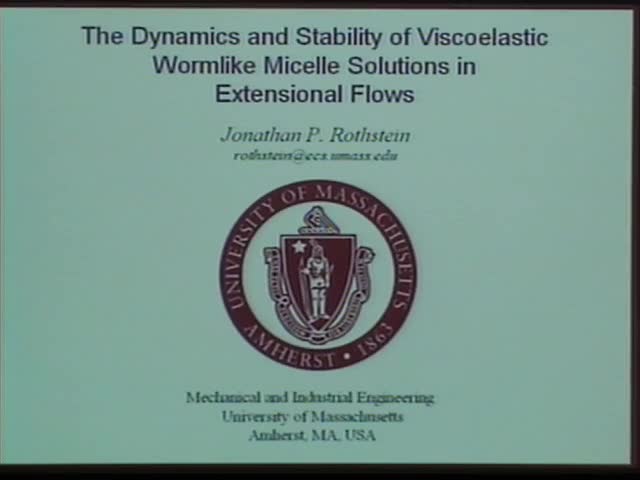The dynamics and stability of viscoelastic wormlike micelle solutions in strong extensional flows
Presenter
October 13, 2009
Keywords:
- Viscoelastic fluids
MSC:
- 76A10
Abstract
Under the proper conditions, surfactant molecules can self-assemble into
wormlike micelles, resembling slender rods, can entangle and impart
viscoelasticity to the fluid. The behavior of wormlike micelles solutions
is similar to that of polymer solutions. The primary difference being that,
unlike covalently bound polymers, micelles are continuously breaking and
reforming under Brownian fluctuations and the imposed shear or extensional
flow field. In this talk, we will discuss the behavior of a series of
viscoelastic wormlike micelle solutions in extensional flows and describe
several newly observed instabilities and flow phenomena unique to these
fluids. In the first part of the talk, we will describe the behavior of
these fluids in the homogeneous uniaxial extensional flow produced by a
filament stretching rheometer. Like polymer solutions, wormlike micelle
solutions demonstrate significant strain hardening and a failure of the
stress-optical. At a critical stress, the wormlike micelle solutions
filaments were found to fail through a dramatic rupture near the axial
midplane. This filament failure likely stems from the local scission of
individual wormlike micelle chains. We will discuss the effect that
pre-conditioning can have on the response of these materials and demonstrate
that the presence of branching in wormlike micelle solutions can significant
reduce the strain hardening of the extensional viscosity. In the second
part of the talk, we will describe how the extensional rheology of these
wormlike micelle solutions can affect more complex flows by presenting a
series of interesting new flow phenomena unique to wormlike micelle
solutions. The experiments will include the observation of a new
instability in the flow past a falling sphere, through a periodic array of
cylinders and past a single cylinder. The flows are investigated through a
variety of experimental techniques including the use of high speed imaging,
particle image velocimetry and flow induced birefringence measurements.
